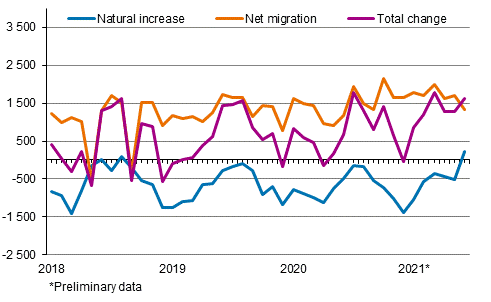Published: 22 July 2021
Number of emigrations in the early part of the year lowest in Finland during the millennium
According to Statistics Finland's preliminary data, Finland's population at the end of June was 5,541,806. During January–June Finland's population increased by 8,013 persons. The reason for the population increase was migration gain from abroad: the number of immigrants was 10,152 higher than that of emigrants, the number of which was the lowest in Finland since 1998. The number of births was 2,707 lower than that of deaths.
Population increase by month 2018–2021*

According to the preliminary statistics for January–June a total of 24,570 children were born, which is 1,639 more than in the corresponding period 2020. The number of deaths was 27,277 which is 661 lower than one year earlier.
According to preliminary data, the birth rate rose slightly from the previous year. Over the previous twelve months (July 2020 to June 2021), the total fertility rate was 1.42, while the figure for the calendar year 2020 was 1.37. The total fertility rate indicates how many children a woman would give birth to during her lifetime if the birth rate remained the same as in the year on which the calculation is based.
Altogether 14,844 persons immigrated to Finland from abroad and 4,692 persons emigrated from Finland during January–June. The number of immigrants was 723 higher and the number of emigrants 1,827 lower than in the previous year. The number of emigrations in the early part of the year was lowest in the 21st century. In all, 3,887 of the immigrants and 2,970 of the emigrants were Finnish citizens. In all, 26 per cent of the immigrants and 63 per cent of the emigrants were Finnish citizens.
According to the preliminary data, the number of inter-municipal migrations totalled 132,526 by the end of June. Compared with the previous year, the increase was 4,250 migrations according to the municipal division of 2021.
Same-sex marriages took legal effect in March 2017. During January–June 2021, same-sex partners entered into 160 marriages of which 105 were between two women and 55 between two men.
According to preliminary data by region, the population grew in Uusimaa, Pirkanmaa, Southwest Finland, North Ostrobothnia, Åland, Päijät-Häme, Central Ostrobothnia, Kanta-Häme and South Ostrobothnia between January–June of 2021.
The population grew most in absolute numbers in Uusimaa, where it grew by 6,856 persons. The next largest increase in population was seen in Pirkanmaa, 1,671 persons. Relative to the population, population growth was highest in Åland, 7.5 per mil, in Uusimaa, 4.0 per mil and in Pirkanmaa, 3.2 per mil. Population loss was highest in absolute numbers in the region of South Karelia that lost 639 persons of its population. The population of North Karelia decreased by 529 persons, which was the second biggest population loss. Relative to the population, the biggest population loss was found in South Karelia, 5.0 per mil.
Most migration gain from intramunicipal and international migration was collected by Uusimaa, 3,965 persons and Pirkanmaa, 1,691 persons. Most migration gain in relative terms based on total net migration was attained by Åland, 6.9 per mil, and Pirkanmaa, Kanta-Häme and Päijät-Häme, 3.2 per mil each.
In absolute numbers, migration loss from total net migration was biggest in the region of Central Finland, 276 persons. In the region of South Karelia the loss was 178 persons. In relative terms, the biggest migration loss from total net migration was found in South Karelia, 1.4 per mil of the population.
During January–June 2021, migration between regions numbered 57,695. The positive gain from migration between regions was seen in Pirkanmaa, Päijät-Häme, Kanta-Häme, South Ostrobothnia, Southwest Finland, North Savo, South Savo, Kymenlaakso, Central Ostrobothnia and Åland. In absolute numbers, the highest gain from migration between regions was received by Pirkanmaa, 1,086 persons. The relative migration gain was highest in Kanta-Häme and Pirkanmaa, in both 2.1 per mil of the population.
Migration loss from migration between regions was biggest in absolute numbers in the region of Ostrobothnia, 696 persons. Migration loss from migration between regions was biggest also in relative terms in the region of Ostrobothnia, 4.0 per mil of the population.
Source: Preliminary population statistics, Statistics Finland
Inquiries: Joni Rantakari 029 551 3249, Joonas Toivola 029 551 3355, info@stat.fi
Head of Department in charge: Hannele Orjala
Publication in pdf-format (251.5 kB)
- Tables
-
Tables in databases
Pick the data you need into tables, view the data as graphs, or download the data for your use.
Appendix tables
- Figures
-
- Appendix figure 1. Live births by quarter 1999 - 2020 and preliminary data 2021 (22.7.2021)
- Appendix figure 2. Deaths by quarter 1999 - 2020 and preliminary data 2021 (22.7.2021)
- Appendix figure 3. Intermunicipal migration by quarter 1999 - 2020 and preliminary data 2021 (22.7.2021)
- Appendix figure 4. Immigration by quarter 1999 - 2020 and preliminary data 2021 (22.7.2021)
- Appendix figure 5. Emigration by quarter 1999 - 2020 and preliminary data 2021 (22.7.2021)
Updated 22.07.2021
Official Statistics of Finland (OSF):
Preliminary population statistics [e-publication].
ISSN=2243-3627. June 2021. Helsinki: Statistics Finland [referred: 26.4.2025].
Access method: http://stat.fi/til/vamuu/2021/06/vamuu_2021_06_2021-07-22_tie_001_en.html

